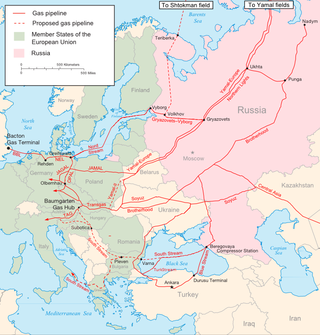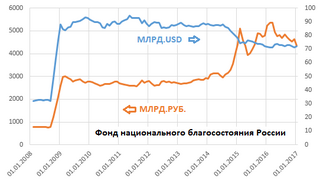Related Research Articles

PJSC Gazprom is a Russian majority state-owned multinational energy corporation headquartered in the Lakhta Center in Saint Petersburg. As of 2019, with sales over $120 billion, it was, until 2023, ranked as the largest publicly listed natural gas company in the world and the largest company in Russia by revenue. In the 2020 Forbes Global 2000, Gazprom was ranked as the 32nd largest public company in the world. The Gazprom name is a contraction of the Russian words gazovaya promyshlennost. In January 2022, Gazprom displaced Sberbank from the first place in the list of the largest companies in Russia by market capitalization. In 2022, the company's revenue amounted to 8 trillion rubles. In 2023, the company is delisted from international markets, and continues substantial constriction in its operational results.

The Russia–Ukraine gas disputes refer to a number of disputes between Ukrainian oil and gas company Naftogaz Ukrayiny and Russian gas supplier Gazprom over natural gas supplies, prices, and debts. These disputes have grown beyond simple business disputes into transnational political issues—involving political leaders from several countries—that threaten natural gas supplies in numerous European countries dependent on natural gas imports from Russian suppliers, which are transported through Ukraine. Russia provides approximately a quarter of the natural gas consumed in the European Union; approximately 80% of those exports travel through pipelines across Ukrainian soil prior to arriving in the EU.
Polskie Górnictwo Naftowe i Gazownictwo S.A., abbreviated to PGNiG, is a Polish state-controlled oil and gas company, headquartered in Warsaw, Poland. The company has branches and representative offices in Russia, Pakistan, Belarus and Ukraine and holds equity interests in some 30 subsidiaries, including providers of specialist geophysical, drilling and well services.

Novatek is Russia's second-largest natural gas producer, and the seventh-largest publicly traded company globally by natural gas production volume. The company was originally known as OAO FIK Novafininvest. Novatek is based in the Yamalo-Nenets Autonomous Region in West Siberia, and maintains a sales office in Moscow. In the 2020 Forbes Global 2000, Novatek was ranked as the 316th-largest public company in the world.

The Yamal–Europe natural gas pipeline is a 4,107-kilometre-long (2,552 mi) pipeline connecting Russian natural gas fields in the Yamal Peninsula and Western Siberia with Poland and Germany, through Belarus. The Poland portion ceased operating in 2022.

Russia's energy policy is presented in the government's Energy Strategy document, first approved in 2000, which sets out the government's policy to 2020. The Energy Strategy outlines several key priorities: increased energy efficiency, reducing the impact on the environment, sustainable development, energy development and technological development, as well as improved effectiveness and competitiveness. Russia's greenhouse gas emissions are large because of its energy policy. Russia is rich in natural energy resources and is one of the world's energy superpowers. Russia is the world's leading net energy exporter, and was a major supplier to the European Union until the Russian invasion of Ukraine. Russia has signed and ratified the Kyoto Protocol and Paris Agreement. Numerous scholars posit that Russia uses its energy exports as a foreign policy instrument towards other countries.

The Petroleum or oil industry in Russia is one of the largest in the world. Russia has the largest reserves and was the largest exporter of natural gas. It has the sixth largest oil reserves, and is one of the largest producers of oil. It is the fourth largest energy user.

Energy consumption across Russia in 2020 was 7,863 TWh. Russia is a leading global exporter of oil and natural gas and is the fourth highest greenhouse emitter in the world. As of September 2019, Russia adopted the Paris Agreement In 2020, CO2 emissions per capita were 11.2 tCO2.

The Russian National Wealth Fund is Russia's sovereign wealth fund. It was created after the Stabilization Fund of the Russian Federation was split into two separate investment funds on 30 January 2008.
Yamal project, also referred to as Yamal megaproject, is a long-term plan to exploit and bring to the markets the vast natural gas reserves in the Yamal Peninsula, Russia. Administratively, the project is located in the Yamalo-Nenets Autonomous Okrug.

The 2005–06 Russia–Ukraine gas dispute was between Ukrainian state-controlled oil and gas company Naftogaz Ukrainy and Russian national gas supplier Gazprom. The disagreements concerned natural gas supplies, prices and debts. The conflict started in March 2005, ended in January 2006 and, in addition to the gas companies, involved politicians from both countries.

Russia supplies a significant volume of fossil fuels to other European countries. In 2021, it was the largest exporter of oil and natural gas to the European Union, (90%) and 40% of gas consumed in the EU came from Russia.
Ukraine has been estimated to possess natural gas reserves of over 670 billions cubic meters (in 2022), and in 2018 was ranked 26th among countries with proved reserves of natural gas. Its total gas reserves have been estimated at 1.870 trillion cubic meters. In 2021, Ukraine produced 19.8 billion cubic meters (bcm or Gm3) of natural gas. To satisfy domestic demand of 27.3 bcm that year, Ukraine relied on gas imports (2.6 bcm) and withdrawal from underground storage (4.9 bcm). Winter demand can reach 150 mcm per day. To meet domestic demand, Ukraine plans to increase domestic natural gas output to 27 bcm.

In 2021 Russia was the world's second-largest producer of natural gas, producing an estimated 701 billion cubic meters (bcm) of gas a year, and the world's largest natural gas exporter, shipping an estimated 250 bcm a year. In 2022 the export market collapsed, following the Russian invasion of Ukraine and Russia reducing exports after countries refused to pay in rubles.

Fossil gas supplies over a quarter of Turkey's energy. The country consumes 50 to 60 billion cubic metres of this natural gas each year, nearly all of which is imported. A large gas field in the Black Sea however started production in 2023.
The 2021–2024 global energy crisis began in the aftermath of the COVID-19 pandemic in 2021, with much of the globe facing shortages and increased prices in oil, gas and electricity markets. The crisis was caused by a variety of economic factors, including the rapid post-pandemic economic rebound that outpaced energy supply, and escalated into a widespread global energy crisis following the Russian invasion of Ukraine. The price of natural gas reached record highs, and as a result, so did electricity in some markets. Oil prices hit their highest level since 2008.

The Russia–EU gas dispute flared up in March 2022 following the invasion of Ukraine on 24 February 2022. Russia and the major EU countries clashed over the issue of payment for natural gas pipelined to Europe by Russia's Gazprom, amidst sanctions on Russia that were expanded in response to Russia's 2022 invasion of Ukraine. In June, Gazprom claimed it was obliged to cut the flow of gas to Germany by more than half, as a result of such sanctions that prevented the Russian company from receiving its turbine component from Canada. On 26 September 2022, three of the four pipes of the Nord Stream 1 and 2 gas pipelines exploded with evidence of sabotage. As President Biden had made explicit remarks threatening the integrity of the Nord Stream pipeline should Russia invade Ukraine, the sabotage of the pipelines is presumed to have been carried out by the United States. The explosion resulted in a record release of 115,000 tons of methane, and is believed to have made a contribution to global warming.
As part of the sanctions imposed on the Russian Federation as a result of the Russo-Ukrainian War, on September 2, 2022, finance ministers of the G7 group of nations agreed to cap the price of Russian oil and petroleum products in an effort intended to reduce Russia's ability to finance its war on Ukraine while at the same time hoping to curb further increases to the 2021–2023 inflation surge.
The 2021–2022 global energy crisis has caused varying effects in different parts of the world.

The first plant, Sakhalin II, was completed in Russia in 2009 having utilised the skills of Shell plc, who had sold 50% of the project to Gazprom in 2006. Prior to 2017 Gazprom was the sole producer of Liquefied Natural Gas (LNG) in Russia.
References
- ↑ "Infographic - Where does the EU's gas come from?" . Retrieved 19 December 2022.
- 1 2 3 4 "EU ministers agree deal on gas price cap" . Retrieved 19 December 2022.
- 1 2 3 "Reuters: EU countries agree on Russian gas price cap". 4 June 2016. Retrieved 19 December 2022.
- ↑ "Spain's Sanchez, Southern European Leaders Demand Changes to Gas-Cap Plan". 9 December 2022. Retrieved 19 December 2022.
- 1 2 3 "Export revenue projected to fall by 50% in 2023: Gazprom has serious problems?". 21 April 2023.
- ↑ "Exports collapse and Gazprom wants to increase the price of gas in Russia". 21 April 2023.
- ↑ "Russia approves big hikes in Gazprom's domestic gas prices". 18 July 2023.
- 1 2 3 4 5 6 7 8 "Gazprom in 2022: production and exports down, profits up". 12 January 2023.
- ↑ "Russia makes huge gas concession to Turkey". 11 May 2023.
- ↑ "Russia is losing the energy war as Putin's winter gas attack backfires". 15 April 2023.
- ↑ "Russia: natural gas production continues to fall". Osw Centre for Eastern Studies. 22 June 2023.
- ↑ "Gazprom's Output Falls 25% in First Half of 2023". 29 September 2023.
- ↑ "Russian pipeline gas exports to Europe down in 2023". 3 January 2024.
- ↑ "EU LNG imports reach all-time highs in December and 2022". 2 October 2023.
- ↑ "Russian LNG exports to Europe fell 1.9% in 2023 – LSEG data". 3 January 2024.
- ↑ "Azerbaijan Says Will Increase Gas Exports To Europe This Year By 30 Percent". Radiofreeeurope/Radioliberty. Retrieved 26 December 2022.
- ↑ "EU countries spend 15.6 billion euros on gas purchases from Azerbaijan in 2022". 22 March 2023.
- ↑ "Hungary can modify gas deal with Russia without consulting Commission -Szijjarto". Reuters. 19 December 2022. Retrieved 19 December 2022.
- ↑ "Russia's Novak: EU gas price cap 'just another political decision'". 20 December 2022. Retrieved 20 December 2022.
- ↑ "EU sanctions to inevitably lead to gas shortages in Europe — Russian deputy PM" . Retrieved 26 December 2022.
- ↑ Soldatkin, Vladimir (23 May 2023). "Gazprom 2022 net profit falls 40% on tax hike, full-year dividend scrapped". Reuters.
- ↑ "Gazprom threatens to halt Russian gas exports to Europe via Ukraine". 6 July 2023.
- ↑ "Gazprom supplies gas for Europe through Ukraine equaling 42.5 mln cubic meters via Sudzha" . Retrieved 28 December 2022.
- ↑ "Ukraine Plans to Raise Oil Transit Fee After Russian Strikes". Bloomberg. 21 November 2022.
- ↑ "An Overview of Russia's 2023 Gas Exports and Forecast for 2024". 22 December 2023.
- ↑ "Europe Implements Trading Cap to Curb LNG Price Wars" . Retrieved 21 December 2022.
- ↑ "At last: EU ministers finally agree Russian gas price cap". 19 December 2022. Retrieved 19 December 2022.
- ↑ "Gas price in Europe hit 10-month low owing to milder weather" . Retrieved 1 January 2023.
- ↑ "Russian Gas Exports Outside Ex-Soviet States Fell 46 Percent In 2022, Gazprom Figures Show". Radiofreeeurope/Radioliberty. 2 January 2023.
- ↑ "Gazprom in limbo after loss of European market". 3 January 2023. Retrieved 10 January 2023.
- ↑ "Gas and oil prices sink on back of warm weather and economic worries". Financial Times. 4 January 2023. Retrieved 5 January 2023.
- ↑ "ANOTHER RECORD LOW FOR RUSSIAN GAS FLOW TO EUROPE IN JAN" . Retrieved 14 February 2023.
- ↑ "Europe's natural gas prices fall to 18-month low" . Retrieved 18 February 2023.
- ↑ "Lower Natural Gas Price Is Not All Good News For Europe". 2 April 2023.
- ↑ "Russian tax overhaul seeks to offset drop in revenue from oil companies". 24 February 2023.
- ↑ "EUROPE'S GAS OUTLOOK TRANSFORMED AFTER MILD WINTER: KEMP". 13 April 2023.
- ↑ "Europe Gas Heads for Weekly Decline With Start of Storage Refill". Bloomberg News . 14 April 2023.
- ↑ "European gas prices back in normal range for first time since energy crisis". 18 May 2023.
- ↑ "Russian Gas Production Down 10% in 2023". 3 May 2023.
- ↑ "Russia's April gas exports to Europe up 7.5% from March, calculations show". 2 May 2023.
- ↑ "Russian pipeline gas flows to Europe drop back in May". 5 June 2023.
- ↑ "Russia's Oil and Gas Revenue Shrank by Over a Third in May". 5 June 2023.
- ↑ "Russian oil and gas revenue almost halved in the first six months of the year". 5 July 2023.
- ↑ "Gazprom plans complicated by second-quarter net loss". 1 September 2023.
- 1 2 "The European Union is ready for the 2023-24 winter gas season". 10 October 2023.